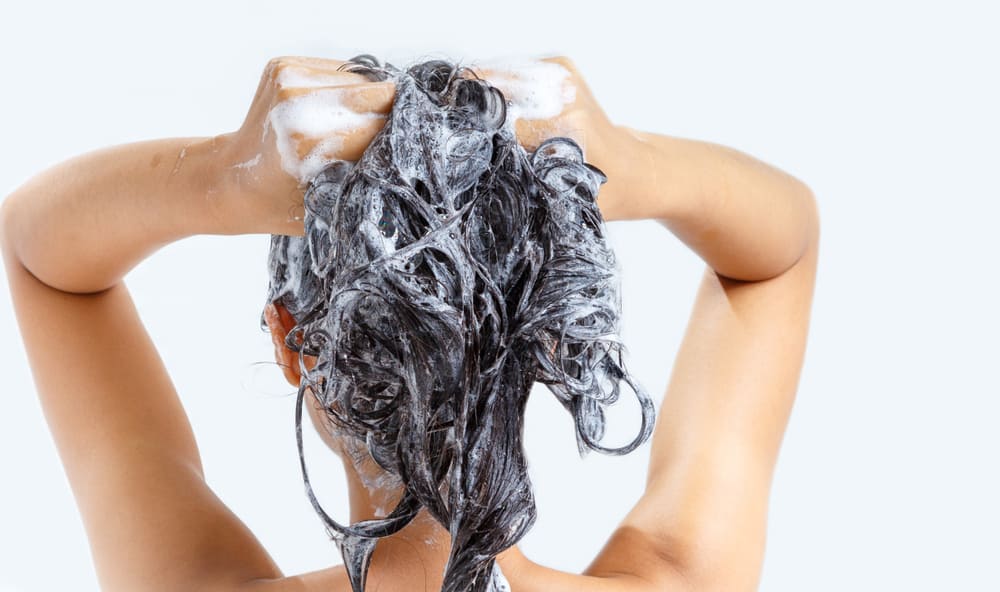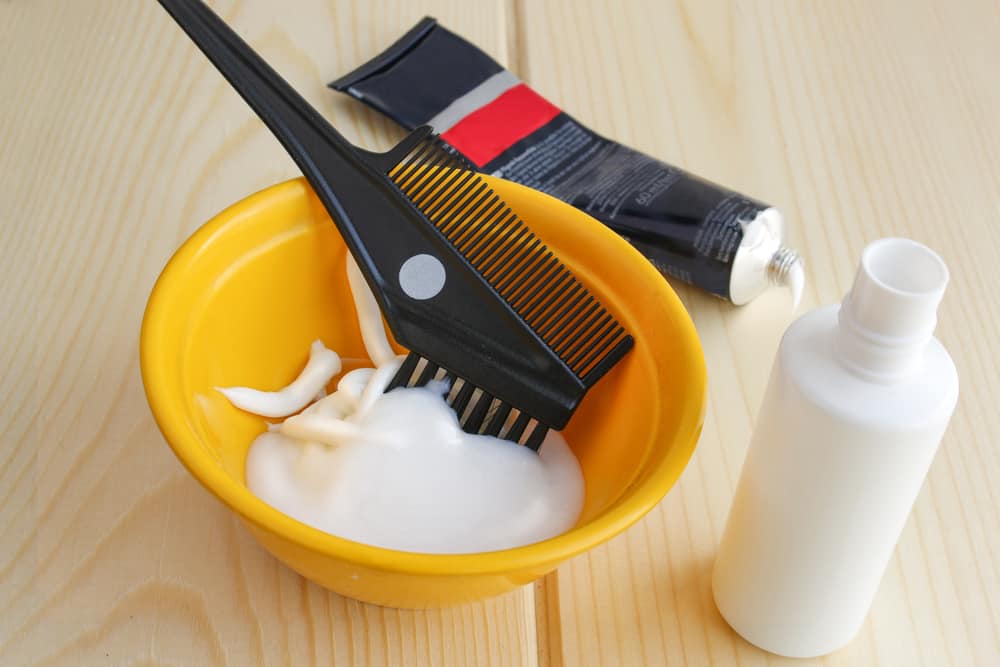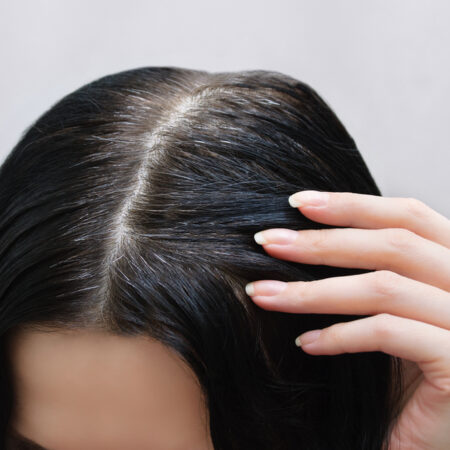If you made the decision to dye your hair any shade of black and then immediately regretted it, there may still be hope for you. While black hair dye can be tricky to remove because of how pigmented it is, there are a few methods that you can use to decrease the intensity of your hair’s color or remove the black dye altogether.
In this article you’ll learn the best, most effective ways to remove black hair dye from your hair. We’ll also discuss how to care for your hair after removing dye from it and give you some tips on removing black hair dye from your skin.
What You Need to Know About Black Hair Dye Removal
Black hair dye is one of the hardest colors to remove, thanks to the chemicals that are used during the dyeing process. In order to saturate your hair’s cuticle and force it to accept the much darker pigment, these chemicals are typically more extreme, and therefore more permanent in your hair. This is also why removing black hair dye without damaging your hair can be very difficult to do.
You should keep in mind that the faster you try to remove your black hair dye, the more likely it is that your hair will get damaged during the process. Like many hair color corrections, it is a much better idea to move the process along slowly, allowing your hair time to recover in between treatments until you reach your desired hair color.
Of course, that is not always possible, so you should make sure to care for your hair properly during the entire process.
The Best Methods for Removing Black Hair Dye

Below, we’ve gathered the most effective and easiest to use methods of removing unwanted black hair dye from your locks.
Clarifying Shampoo
A fairly straightforward approach, using clarifying shampoo on a regular basis after dyeing your hair black can help to lift and lighten the pigment. This method does take several weeks to work properly, but it is a good choice if you don’t want to put any type of bleaching or color removal chemicals on your hair.
A surprisingly effective brand of shampoo to use is Head and Shoulders. Simply use the shampoo 3 to 4 times a week and follow up with a conditioner, as clarifying shampoo tends to leave your hair dry. You can stop use of the clarifying shampoo once your hair has lightened to a desired color.
Color Remover
Color removers, like Color Oops, are chemical-based dye removal products that work to strip the cuticles of pigments, allowing the hair to become lighter. Depending on the type of black dye you used and your original hair color, you can have varying levels of results—but for the most part, a color remover can drastically lighten your hair with just one use.
Keep in mind that the chemicals in a color remover can leave your locks feeling dry or looking frizzy, so it’s a good idea to follow up the process with a deep conditioning treatment, allowing your hair to rehydrate before you attempt anything else with it.
Toner
A toner is the perfect option if you’ve dyed your hair black, but it isn’t exactly the shade of black you want it to be. When mixed with a low-volume developer, like a 10-volume developer, a toner can lighten hair slightly and deposit new pigments into the black, leaving you with a more desired color.
However, toner won’t be able to completely lift black hair dye off of your locks. If your intent is to completely lighten your hair and remove the black dye so you can then dye it blonde or a similar color, you are better off trying more extreme methods like a bleach bath or a color remover.
Bleach Bath
If you don’t mind using chemicals on your hair, a bleach bath is a simple way to lighten black pigment from your hair without you having to carefully bleach your entire head. While a whole-head bleaching is an option, it is not recommended for dyed black hair as the chemicals of the black dye can mix badly with the bleach chemicals, leaving your hair irreparably damaged.
With a bleach bath, you are diluting the bleach with shampoo and applying it to wet hair, reducing the risk of extreme hair damage.
For this method to work, mix bleach and a 30-volume developer one to one in a mixing bowl. From there, add enough shampoo to equal the amount of bleach and developer combined.
Mix the bleach bath ingredients thoroughly, and then apply the mixture to wet hair, working from the ends of your hair up to the roots.
Move as quickly as possible, but still be careful to ensure you don’t miss any spots or you will be left with patches of dark hair. You should also avoid lathering the bleach mixture as if it was shampoo because this can damage your scalp.
Leave the bleach mixture applied for between 10 and 20 minutes before rinsing off with warm water.
You can repeat this process in a few days if you find that your hair is still not light enough after the first wash.
Check out this video to find a detailed tutorial on applying a bleach bath that can help you further understand the process.
Baking Soda
In most cases, home hair remedies for removing dye are not recommended because of the risk they carry. Most of these treatments can be extremely drying to hair and may react strangely to whichever dye you have applied.
That being said, if you are in a pinch, you may be able to use baking soda to help lighten your hair.
Mix 2 tablespoons of baking soda with your favorite shampoo until a smooth paste is formed. If needed, add a little water to the mixture to thin it out. Apply the mixture onto your hair like you would regular shampoo. Allow it to sit for a few minutes and then wash it out with warm water.
Once all of the baking soda mixture is washed out, apply a mixture of conditioner and 1 tablespoon of white vinegar to your hair. The vinegar will neutralize any lingering baking soda and will be undetectable when mixed with conditioner.
This remedy is great if you don’t have any other options available, but you shouldn’t use it too often because baking soda can be very drying to hair. Make sure to follow up with a conditioning treatment after use and wait several days in between applications if your hair was not light enough after your first try.
When to See a Professional About Color Removal
Once you’ve dyed your hair black at home, you may be a little unwilling to head to a salon and confess to a professional stylist what you’ve done. However, if you have concerns about removing the black dye from your hair or about your hair’s overall integrity, it is a good idea to consult with a stylist.
A professional hairdresser will be able to evaluate your hair’s needs and remove most of the black dye without causing too much damage to your locks. If you’re worried you will mess up your hair further by trying to remove unwanted black hair dye, seeing a professional about it is the best way to go.
Removing Black Hair Dye From Your Skin
If you got a little carried away when applying your black hair dye, you may be left with some less than pleasant hair dye stains on your skin around your hairline or hands. Because it is so pigmented, black dye stains can be difficult to remove, but some elbow grease and a little bit of rubbing alcohol can take these stains off.
For removing black dye from your skin, apply a small amount of rubbing alcohol onto a cotton pad and then rub it lightly over the skin. Once the stain is gone, wash the rubbing alcohol off the area completely. Keep in mind that rubbing alcohol may irritate the skin, so try and use it sparingly. And if you want alternatives to using rubbing alcohol, check out this article for more tips.
Can You Redye Your Hair After Removing Black Hair Dye?

Once your hair has been lightened to your desired color and no more black hair dye remains, you can redye it to a different color.
However, you should take into account that trying to go from black to a very light color will likely take a lot of effort and will probably need bleaching to achieve. Always be sure to use a color remover before applying a whole-headed bleach application to prevent your hair from becoming too damaged.
Additionally, sometimes removing black hair dye strips your hair of other pigments. You may need to use a color filler to build the cuticles of your hair back up and strengthen them to where they can hold a new lighter color without looking murky or dull.
You should consult with a professional if you have any concerns over redyeing your hair.
Caring for Your Hair After Black Dye Removal
During and after the process of black dye removal, your hair runs a high risk of becoming dry or damaged. Caring for your locks properly during this time can help negate some of these effects and leave your hair feeling strong and soft.
Nourishing Your Locks
Supplying your hair with the proper vitamins and minerals it needs to remain soft and strong can go a long way to prevent and repairing damage. Eat a diet packed with plenty of healthy fatty acids and nutrients, and try out hair oils to boost the health of your tresses.
Adding Hydration
Hair dryness is one of the most noticeable symptoms of hair damage, so if you’re experiencing crunchy, dry hair, or unmanageable frizz, it may be time to add some hydration back into your locks. You can use deep conditioning treatments to do this, in addition to hair oils or DIY hair moisturizing recipes.
Strengthening Treatments
Strengthening treatments such as Olaplex feature bond builders that work to repair your hair cuticle from the inside out. Using one of these products on a regular basis can help to fortify your hair against damage and future breakage.
Achieving the Best Hair Color for Your Style
So, you tried out black hair dye and decided it wasn’t for you. It may seem like the end of the world, but fortunately, there are many methods available to you that work to efficiently and quickly lighten the black pigments out of your hair.
It can be a tricky process, but with patience and proper hair maintenance, you can eventually remove your black hair dye, leaving you with a lighter hair color and a clean slate you can try out a more fitting color on.
